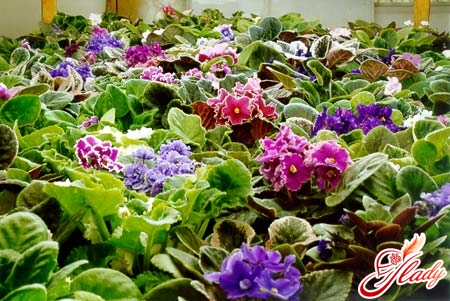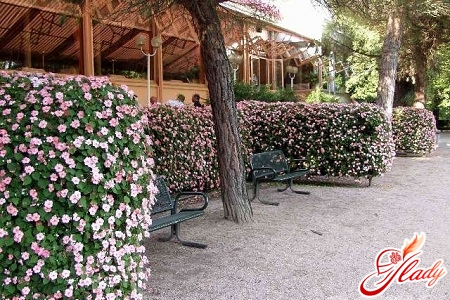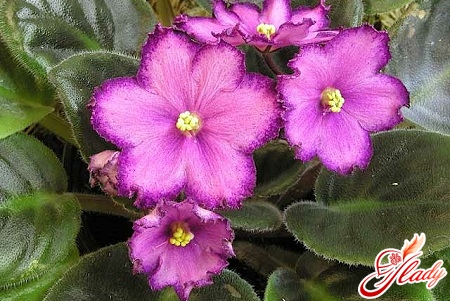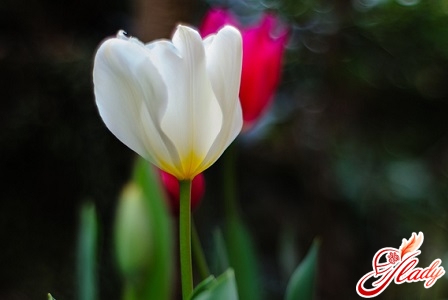 Few people remain indifferent to the bloomingindoor plants. And amateur flower growers always try to add at least one such specimen to their collection. However, most often, they prefer some simple and unpretentious flowers. That is why all sorts of geraniums and violets usually adorn our windowsills. But not everyone would dare to grow, for example, gloxinia, fuchsia or cyclamen. This is especially true for such a plant as Persian cyclamen. The thing is that it blooms, of course, stunningly beautifully! However, after flowering, this species enters a period of rest, sheds its leaves and loses its decorative effect. So, many inexperienced flower growers confuse this period of rest with the death of the plant, and therefore simply throw away the tuber that has lost its leaves. But even more experienced lovers of indoor plants do not always know how to properly preserve the tuber and achieve repeated flowering of cyclamen. This fact scares many people who want to get this gorgeous flower. All you need to do is know the rules for caring for the plant and strictly follow them. We offer you a short educational program on this topic, and at the same time a little information about the spectacular and bright Persian cyclamen.
Few people remain indifferent to the bloomingindoor plants. And amateur flower growers always try to add at least one such specimen to their collection. However, most often, they prefer some simple and unpretentious flowers. That is why all sorts of geraniums and violets usually adorn our windowsills. But not everyone would dare to grow, for example, gloxinia, fuchsia or cyclamen. This is especially true for such a plant as Persian cyclamen. The thing is that it blooms, of course, stunningly beautifully! However, after flowering, this species enters a period of rest, sheds its leaves and loses its decorative effect. So, many inexperienced flower growers confuse this period of rest with the death of the plant, and therefore simply throw away the tuber that has lost its leaves. But even more experienced lovers of indoor plants do not always know how to properly preserve the tuber and achieve repeated flowering of cyclamen. This fact scares many people who want to get this gorgeous flower. All you need to do is know the rules for caring for the plant and strictly follow them. We offer you a short educational program on this topic, and at the same time a little information about the spectacular and bright Persian cyclamen.
Biological portrait
Persian cyclamen is also known asnames Alpine violet and Dryakva. This is a separate species of plants from the genus Cyclamen, belonging to the Myrsinaceae family. It is a tuberous root perennial herbaceous plant no more than thirty centimeters high. The tubers of Persian cyclamen do not exceed fifteen centimeters in diameter and are distinguished by the presence of a single growth point. The leaves of the Persian cyclamen can be colored from light to dark green and have a characteristic silvery pattern on the surface. The plant does not have a stem, and its leaves grow directly from the bulb, and therefore are called basal. The shape of the leaves is heart-shaped, and the size varies from five to ten centimeters in diameter. During flowering, long peduncles appear on the plant, rising above the rosette of leaves and crowned with graceful flowers. The flowers of the Persian cyclamen have five petals, the lower of which is bent back. Therefore, the flowers of the cyclamen resemble butterflies circling above a green bush, which gives the plant a special decorative effect. The color of the flowers varies from snow-white to dark burgundy. In the wild, Persian cyclamen grows in Iran, Asia Minor and the Mediterranean. Persian cyclamen has been known since ancient times. According to ancient chronicles, this plant was grown in the gardens of Ancient Rome along with violets and daffodils. Ancient and medieval healers used cyclamen tubers to treat sinusitis and rheumatism, as well as an antidote for poisonous snake bites. Currently, preparations from cyclamen tubers are used in homeopathy.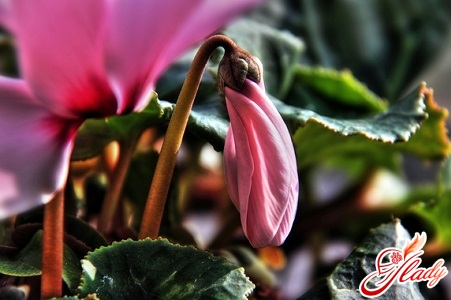
Varieties and hybrids
Today the Persian cyclamen is presenteda huge number of varieties and hybrids that differ in color, shape and size of leaves, texture, color and size of flowers, as well as compactness and size of the bush itself. Among the various varieties of Persian cyclamen, you can find specimens with fringed petals, with especially fragrant flowers, as well as standard-sized plants, low-growing and dwarf. We present you with a list of particularly popular varieties of Persian cyclamen. Lines of standard varieties (tall plants)
- Decora. Appreciates the pastel colors of flowers. The leaves of plants of this line have a characteristic marble pattern, and the flowers are painted in soft, soft colors.
- Firmament. Interest and value as a line of early-crowned cyclamen. Valued also for the large size of flowers.
- Rex. A line of cyclamen of compact size with decorative leaves, which have a silvery marble pattern.
- Ruffled. It is distinguished by flowers with wavy petals.
- Swetheart. Valued for the decorativeness of the leaves and a strong aroma of flowers.
- Triumph. A line of large-flowered varieties with decorative leaves.
Lines of low-growing varieties (up to 22 centimeters in height)
- Kaori. A line of dwarf plants with very fragrant flowers. A distinctive feature of the flowers is the contrasting bright middle.
- Mirabelle. A line of small-leaved varieties with flowers of various colors.
- Puppet. Miniature plants with especially fragrant flowers.
- Tiny Mites. The line of the smallest cyclamen is represented by varieties with a variety of colors.
- Turbo Laser. Sredneroslye varieties, characterized by compactness, rapid growth and abundant flowering.
Care of the plant
Proper care of cyclamen is the key to itssuccessful cultivation. First of all, it is necessary not to make mistakes when buying a flower. For example, it is necessary to carefully examine the above-ground base of the corm for rot. This should be done by carefully moving the leaves apart and examining the surface of the tuber protruding above the soil. As a rule, cyclamens are purchased at the beginning of the flowering period - in September-October. After this, it is necessary to allow the plant to acclimatize and provide it with the most correct care. For example, it is important to choose a comfortable location for it. Cyclamens are light-loving plants, but they do not tolerate (or tolerate with difficulty) direct sunlight. Therefore, for this flower you need to choose a place that is well lit, but protected from direct sunlight. The ideal place for cyclamen will be the window sills of the eastern and western windows. On the northern window, the flower will experience a lack of light, and on the southern one, the lighting will be excessive. Nevertheless, even the southern window can be adapted as a place for the flower, but it should be shaded from direct sunlight. Proper care of cyclamen implies not only the correct lighting regime, but also a comfortable atmosphere in the room. The air in the room should not be dry and heavy. This flower grows very poorly in stuffy rooms, and reacts painfully to drafts. Therefore, when airing the room, cyclamen should be taken out of the room, and the flower pot should not be placed near hot batteries and heating devices. For the same reason, cyclamen does not feel good in the kitchen. By the way, the temperature in the room where cyclamen grows should not be too high - this flower does not tolerate heat. The optimal temperature for keeping Persian cyclamen is no higher than twenty degrees during the day and about fifteen at night. Caring for cyclamen in terms of watering comes down to timely and moderate soil moistening. The regime for each plant is selected individually. Here, much depends on the size of the flower, the size of the pot, and the location of the plant. The main condition is not to over-moisten the soil and not allow water to stagnate in the pot. The flower tolerates a lack of moisture much easier than its excess. Therefore, it is necessary to water the cyclamen as the top layer of soil dries out, and after watering, be sure to wipe the bottom of the pot and tray dry. For watering, use only settled or filtered water at room temperature. Remember that excessive watering will lead to rotting of the tuber and death of the plant. In addition, pests - springtails or cyclamen mosquitoes - can appear in constantly damp soil. To maintain the required level of air humidity, the flower must be periodically sprayed.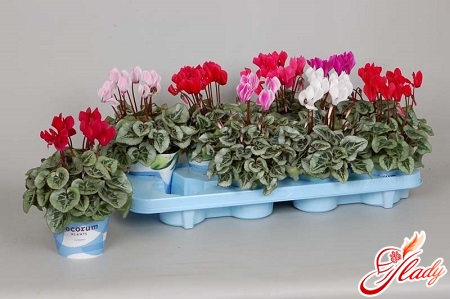
The rest period
After the flowering period, Persian cyclamenenters a dormant phase. At first, the plant gradually sheds its flowers, and then its leaves. By the beginning of the dormant period, only the tuber remains in the pot. Many inexperienced gardeners take this condition for the death of the plant and throw it away. In fact, you only need to provide the flower with appropriate resting conditions. To do this, gradually reduce watering as soon as flowering begins to cease. Then, remove all dead flower stalks and leaves from the plant and allow the soil in the pot to dry out completely. After this, the pot with the tuber should be moved to a dark and cool room, but you cannot put it in the refrigerator. You should also not completely forget about the flower, since its life processes do not stop. Therefore, you need to water the resting tuber occasionally, keeping the soil slightly moist. The first signs of leaving the dormant period are the appearance of new shoots. At this time, you should transplant the tuber into a new pot, replacing the soil in it. When transplanting, you need to leave the upper third of the tuber above the ground. After transplanting, you should resume caring for the flower according to all the rules. It is worth noting that although the Persian cyclamen can bloom repeatedly for several years, it produces fewer and fewer flowers over time. Therefore, after two or three years of cyclamen life, it should be propagated by ordinary division of the tuber, forming a new full-fledged plant. The flower can also be propagated by seeds, which is a more gentle and effective method. The collected seeds are sown in steamed soil and covered with a saucer. The soil in the pot with seeds is moistened very carefully and moderately. After the first sprouts appear, the saucer is removed, and at the stage of two or three true leaves, the seedlings are dived into separate pots. In this way, new specimens of this gorgeous house flower are obtained, which will allow it to live almost forever. The main thing is to provide the cyclamen with proper care. Good luck!




